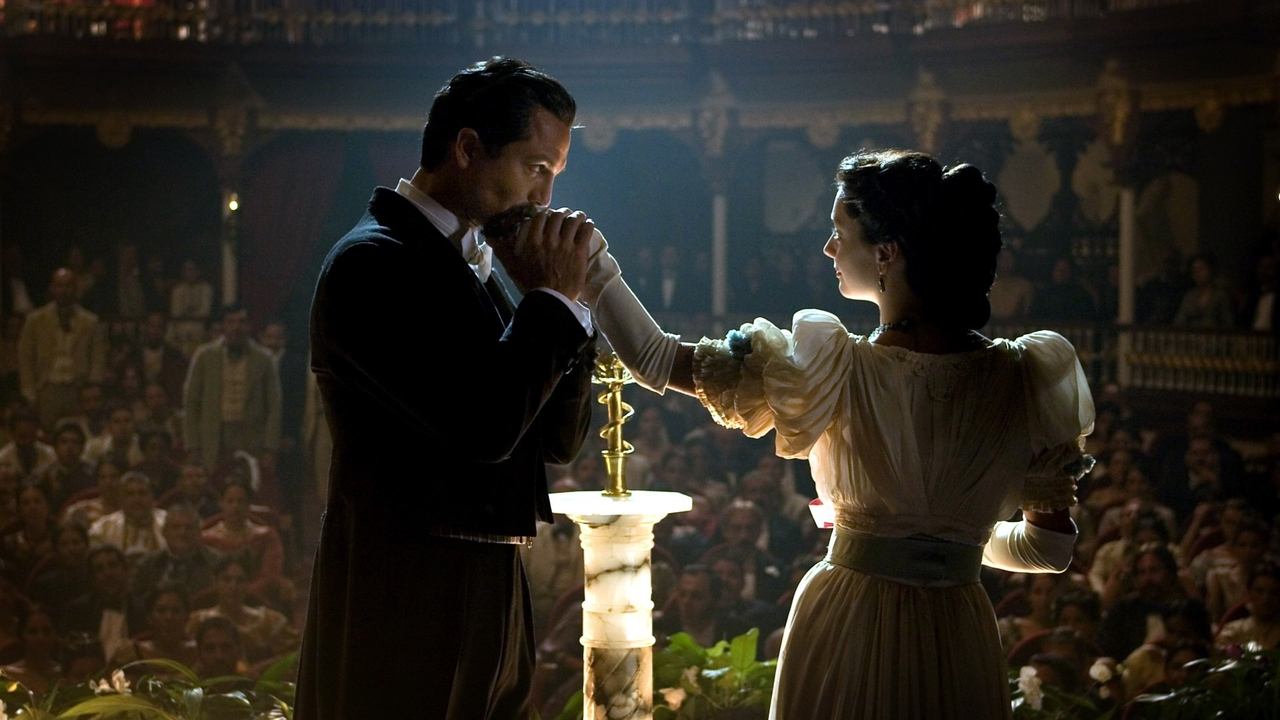setessmer-229-698849
This was such a poorly done film. Having read (and loved) the book, watching this was torture for me. I felt like it had the potential to be a great film, but the majority of the acting was just mediocre. The rhythm of the film just did not work. The script was poorly done. None of the soul of the book was in this film. A couple of the actors' talent was evident. I got the Impression that Javier Bardem was possibly the only cast member who unterstood his character and the story (perhaps he read the book?). Aside from a couple of exceptions, the rest were not at their best in this film. I'll stop now before I write a thousand word rant.Just, disappointing.
billcr12
Once again, Javier Bardem proves to be one of the best actors in the world. Combining with Gabriel Garcia Marquez's novel of the title, the result is a powerhouse of emotion. Bardem is Florentino Arizo, and he falls in love with Fermina Daza, and they write letters to each other and agree to be married. Her father is against the idea, and he sends her to her grandmother and aunt. Years later, she marries her father's choice, Dr. Juvenal Urbino(Benjamin Bratt), and they remain together for fifty years.Florentino vows to remain a virgin when he loses Fermina, but his mother sets him up with a voracious widow who changes his mind very quickly. He keeps a diary detailing his sexual encounters, which build up into the hundreds through several decades. In spite of his escapades, he never forgets his one true love. The difficulty of translating a great novelist is always a challenge. Maybe because I have not read the book, my perspective is different from the many negative reviews of those who compare the two. I found the movie entertaining as a romance spanning fifty years and Bardem is always fun to watch.
ange_gabb
Part epistolary romance, part case study of a furtive and nerdy Casanova, Love in the Time of Cholera (El amor en los tiempos del cólera) reveals a male protagonist's optimistic and cynical perspectives of love. Portrayed with eloquence, charm and emotional complexity by Javier Bardem - who comes from a long line of thespians in Spain - Florentino Ariza surveys love's progression as an incurable disease. Hence, the cleverness of the film's title, for cholera during the periods depicted in Love in the Time of Cholera brought death quickly whereas love festers indefinitely.In one of the most poignant moments of the 2007 film, a middle-aged Florentino utters to his dementia-ravaged mother: "You confuse cholera with love." Florentino's longing for the beautiful Fermina Daza was so intense, that his mother believed cholera to be the blame for his frequent bouts of vomiting and melancholia. That Gabriel García Márquez, author of the 1985 novel El amor en los tiempos del cólera, upon which the epic film is based, likens love to a terminal disease is an apt comparison. Such a romantic concept reverberated (with no small debt to John Barry's sweeping score) in Jeannot Szwarc's 1980 film Somewhere in Time, adapted unfaithfully from the 1975 novel Bid Time Return by Richard Matheson. In Somewhere in Time, a playwright (portrayed by Christopher Reeve) is described as having "died of love" after obsessing over a photo portrait of Belle Epoque actress Elise McKenna (portrayed by Jane Seymour) and willing himself back to her time in order to meet and fall in love with her.In both films - Love in the Time of Cholera and Somewhere in Time - the viewer is challenged to redefine time beyond a cold, scientific certainty and to explore the interrelatedness of memories, emotions and metaphysics. Without relying on the special effects that action, sci-fi and horror flicks have conditioned our minds to accept as a requisite for magical occurrences, "Gabo" - as García Márquez is affectionately known in Latin America - asks us only to open the four chambers of our hearts, figuratively speaking. He implores us to feel the love (Lion King reference unintentional) that makes life worth living despite the social and economic chaos that often surrounds and threatens to desensitize us.Love is the unseen but omniscient character in Love in the Time of Cholera, Somewhere in Time and another period film: Como agua para chocolate (Like Water for Chocolate) from director Alfonso Arau and adapted from the same-titled novel by Laura Esquivel. Esquivel's story is enchanting because it shouts from the rooftops that love holds the power to heal the wounded hearts of distanced lovers - whether the pair is separated by geography, disapproving parents, envious third parties, or any combination thereof. In fact, in Como agua para chocolate, when forbidden lovers Tita (Lumi Cavazos) and Pedro (Marco Leonardi) finally come together, Marco's voice booms: "TE AMO!" What follows in the barn is a literal combustion. Well, the fact that Tita had swallowed nearly an entire box of matches prior to their consummation was an eerie clue.Another dose of "magical realism" - an artistic technique first recognized in American visual art of the mid-20th century and later employed in progressive literature by Latin American writers in the '60s and '70s - that transferred well from Esquivel's story to Arau's picture was the series of haunting sequences which result from Tita psychologically battling her destiny. Tita's fate may have been to become a spinster, but with Pedro's sensual aid she finds her way. As the youngest daughter, she is fated to take care of her widowed mother, Mamá Elena (Regina Torné), until her death. But when Tita reciprocates Pedro's flirtation to the point of infusing eroticism into the scrumptious dishes that she prepares for the family (which expands after her sister Rosaura's marriage to Pedro), a curse about which Mamá Elena warned is cast.Speaking of Como agua para chocolate, much in the way Pedro professes "amor" from the top of his lungs in that torrid barn scene mentioned earlier in this review, hoodlum-Romeo Antone a/k/a "Tony" (Richard Beymer) in West Side Story painfully shouts his beloved's name, "MARIA!" on an urban street. In the first half of West Side Story, however, Tony envisions only love's promise, not its sometimes tragic consequences. The agonizing truth of the controversial affair between Tony and María (Natalie Wood) comes across as brutally honest as an admission in a long-avoided confessional booth when the youths perform "Somewhere." And María's divinity, in Tony's eyes, rings as true as a cathedral bell when his dubbed voice sings the ballad "María": "The most beautiful sound I've ever heard, María, María, María ... Say it loud and there's music playing. Say it soft and it's almost like praying."Holiness takes a holiday in the motives of Florentino, however. Though he frequently refers to Fermina as his "crowned goddess" to anyone willing to listen, he indulges in mucho carnality throughout Love in the Time of Cholera. He is deliberate in going about a purely sexual catharsis in order to alleviate emotional pain caused by Fermina's rejection. When he first spoke of his love for her, Fermina felt honored, but after a while, enough is enough!The rape of Florentino (in his 20s, presumably) is presented by director Newell and screenwriter Ronald Harwood as a misogynistic justification for Florentino's debauchery. After Florentino beds down (with desks, walls and leafy forests sometimes replacing mattresses as props) more than 600 women well into his 70s, he loses the viewers' sympathy with the abruptness of a Victrola's needle skidding across a vinyl record.A second chance at love often requires much suffering on the part of the one whom love was denied. In that sense of murky optimism, Love in the Time of Cholera elevates love to the most sublime affliction. "Gabo" probably would agree with that diagnosis.
Sharicespieces
The film adaptation of the famed piece of Spanish literature, Love in the Time of Cholera by Gabriel García Márquez, is not an entirely accurate portrayal of this conflicting love story. In the civil war-ridden nation of Columbia, circa 1880, with the devastating cholera epidemic continuing to ravage the country, a conflicting love story is inspired. Fermina Daza, a prudent young girl with a tyrannical father, inadvertently attracts the eye of Florentino Ariza, a telegraph boy with a romantic nature. He falls hopelessly in love and pursues her with intimate letters. As she responds, a passionate bond grows and they share this love together. However her feelings are more reserved than her lover's. In the book, García Márquez explains "In reality they were distracted letters, intended to keep the coals alive without putting her hand in the fire, while Florentino Ariza burned himself alive in every line." (pg. 69) Florentino's intense devotion to her could be a consequence of spending most of his time overwhelming himself with love themed literary works. Fermina is yet a less vulnerable character. However, Fermina's father discovers her secret affair and has other plans for her. He threatens Florentino, then forces an involuntary move upon Fermina to separate the star-crossed lovers. Fermina travels with her father for about three years, while concealing her contact with Florentino over telegrams. They remain sure of their arrangements to marry, until comes back from traveling. The moment she sees him upon her return, she realizes that their love was an illusive product of immaturity. Florentino is left heartbroken and vows that he will love her until he dies. She marries a distinguished doctor, with the support of her father. Florentino maintains 622 affairs, using sex to mend his heartbreak while waiting for Fermina's husband, Dr. Urbino, to die of old age. Until, at the age of about 70, Dr. Urbino finally dies and Florentino makes his move. Offended, Fermina disgraces him and is left to grieve for her dead husband. After time, Fermina and Florentino's love is rekindled carefully. They spend valuable time together on a cruise, and Florentino's purpose for life is obtained. In the movie, Florentino is shown as a love-stricken man with a pathetic and creepy obsession. His character is almost irritating to watch. García Márquez hints at these elements in the book, but they are not so dominant as in the film. Also, the connection between Fermina and Florentino is not described in the movie to the extent that it is narrated in the book. Although she does return her love for him in the movie, their deeper connection and agreement still does not appear on screen. In the novel, they exchange love letters for about five years (since she was thirteen years old) and had thoroughly planned their engagement. The film seems to ignore their character development in that aspect and continue to demonstrate them as two distant lovers lacking union. When she first realizes Florentino's affection towards her, she does not predict him to be admirable or serious. Her experimenting with his attachment in the beginning evolves into a real one on her part. Márquez writes, "These unexpected, almost childish antics caused an unfamiliar curiosity in Fermina Daza, but for several months it did not occur to her that it could go any further. She never knew when the diversion became a preoccupation and her blood frothed with the need to see him
" (pg. 58) . The movie illustrates half the events and insight needed to get the main ideas across. I strongly suggest that if you are interested in this movie that you read the book before hand. It will not be as typical and the situations will not seem as unrelated as they do in the film. The only way to enjoy this movie is to understand the story further than what you are shown. PS> The movie also does not explore Fermina and Dr. Urbino's marriage as though it should have been (read the book). He is also a very prized citizen in the book, having founded numerous organizations and leading many foundations. He is portrayed differently in the movie.


 AD
AD




